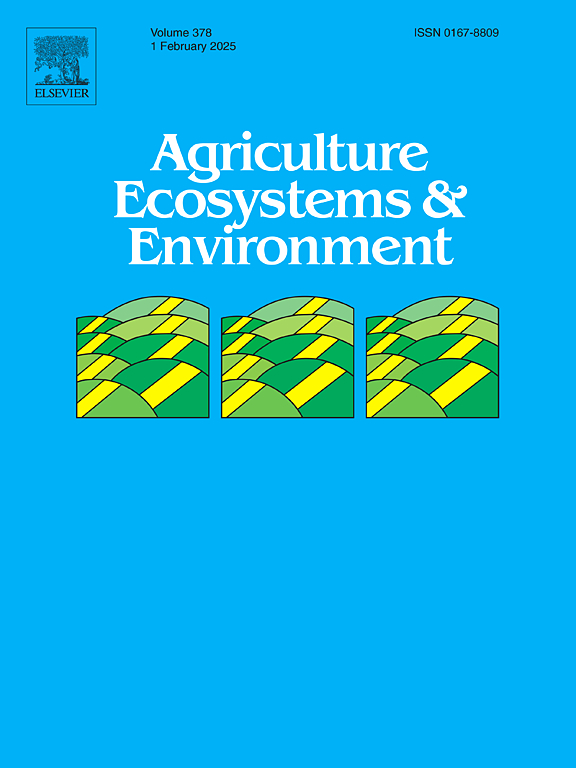中国西北部木乌斯沙地井灌区玉米蒸散量与地下水之间的耕地尺度相互作用
IF 6
1区 农林科学
Q1 AGRICULTURE, MULTIDISCIPLINARY
引用次数: 0
摘要
了解地下水位波动下的水通量和地下水对植物用水的贡献对于半干旱地区地下水资源的可持续利用和保护健康的生态系统至关重要,例如中国西北部的木乌苏沙地(MUSL)荒漠绿洲耕地。在木乌苏沙地的绿洲耕地上进行了为期 3 年的田间试验,共设 5 个处理,地表灌溉深度从 5 毫米到 60 毫米不等,每年灌溉 5 到 11 次。通过实验室测量确定了该地点土壤的主要物理特征。对玉米田中每次灌溉深度为 45 毫米的处理(I45)的不同水源中的氢和氧同位素(氘和氧 18)进行了现场取样分析,并利用 IsoSource 模型进一步确定了根系吸水量(RWU)。利用观测数据对基于 HYDRUS-1D 的土壤水通量数值模型进行了校准和验证,以估算各种灌溉处理下的实际蒸散量(ETa)和水分生产率(WP)。同位素分析表明,在 I45 处理中,玉米在生长阶段吸收了地下水和土壤水。地下水中较大的负 d-excess 值表明,灌溉回流造成了补给水的二次蒸发效应。根据 Hydrus-1D 的模拟结果,2014 年至 2016 年期间,当地下水位深度在 0.81 米至 1.13 米之间时,地下水的使用占 I45 处理玉米蒸散发的 9%至 37%。绿洲耕地的最佳灌溉深度为 37 毫米/次,可实现最高产量和可湿性粉剂。即使在降雨概率为 16% 的干旱年份,玉米产量也不会因地下水毛细管上升和抽取地下水灌溉而受到影响。这些结果为在毛里求斯沙漠绿洲农田和其他具有类似土壤质地、气候条件和种植方式的地区灌溉春玉米的农业用水管理提供了潜在的科学启示。本文章由计算机程序翻译,如有差异,请以英文原文为准。
Cropland-scale interaction between maize evapotranspiration and groundwater in a well-irrigation district in Mu Us Sandy Land, Northwest China
The knowledge of the water fluxes and groundwater contributions to plant water use under fluctuating groundwater levels is crucial for the sustainable utilization of groundwater resources and the preservation of healthy ecosystems in semi-arid regions, such as the desert oasis croplands in the Mu Us Sandy Land (MUSL), Northwest China. A 3-year field trial was conducted in an oasis cropland within MUSL, involving five treatments with surface irrigation depths ranging from 5 mm to 60 mm per application and 5 to 11 irrigation applications per year. The major physical characteristics of the soils at the site were ascertained through laboratory measurements. Hydrogen and oxygen isotopes (deuterium and oxygen 18) in different water sources for the treatment with an irrigation depth of 45 mm per application (I45) in the maize field were analyzed from in situ samples, and root water uptake (RWU) was further identified using the IsoSource model. A numerical model based on HYDRUS-1D for soil water fluxes was calibrated and validated using observation data to estimate the actual evapotranspiration (ETa) and water productivity (WP) under various irrigation treatments. The isotope analysis indicated that maize water uptake in the I45 treatment incorporated both groundwater and soil water during the growing stage. The large negative d-excess values in groundwater suggested a secondary evaporation effect of recharge water due to irrigation return flow. According to simulations with Hydrus-1D, groundwater use contributed 9 % to 37 % of the maize ETa for the I45 treatment between 2014 and 2016 when the depth to the water table varied between 0.81 m and 1.13 m. With an optimal irrigation depth of 37 mm per application, the maximum yield and WP can be achieved in oasis cropland. Even in dry years, with a 16 % probability of rainfall occurrence, maize production was not affected due to the capillary rise of groundwater and the pumping of groundwater for irrigation. These results offer potential scientific insights for agricultural water management of spring maize under irrigation in desert oasis farmlands of the MUSL and other regions with similar soil texture, climatic conditions, and cropping practices.
求助全文
通过发布文献求助,成功后即可免费获取论文全文。
去求助
来源期刊

Agriculture, Ecosystems & Environment
环境科学-环境科学
CiteScore
11.70
自引率
9.10%
发文量
392
审稿时长
26 days
期刊介绍:
Agriculture, Ecosystems and Environment publishes scientific articles dealing with the interface between agroecosystems and the natural environment, specifically how agriculture influences the environment and how changes in that environment impact agroecosystems. Preference is given to papers from experimental and observational research at the field, system or landscape level, from studies that enhance our understanding of processes using data-based biophysical modelling, and papers that bridge scientific disciplines and integrate knowledge. All papers should be placed in an international or wide comparative context.
 求助内容:
求助内容: 应助结果提醒方式:
应助结果提醒方式:


